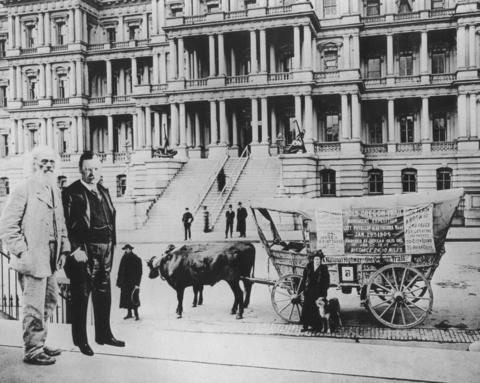Identity elements
Reference code
Name and location of repository
Level of description
Item
Title
WO 155538-F
Date(s)
- 1907 (Creation)
Extent
Name of creator
Content and structure elements
Scope and content
ca. 1907. Copy of customer print. Composite picture where President Teddy Roosevelt has been inserted to stand next to Northwest pioneer Ezra Meeker before the old State Department's "War and Navy" building in Washington D.C., upon the conclusion of Meeker's reenactment of his 1852 journey via covered wagon on the Oregon Trial. Signs decorating the old prairie schooner indicate that Meeker had left Puyallup on January 29, 1906, and arrived in Indianapolis, Indiana on January 5, 1907, a distance of 2,610 miles. Accompanied by his faithful dog "Jim," Edward Songer and Mr. and Mrs. Herman Goble, the 76-year-old Meeker and his yoke of oxen and wagon were a throwback to the days of westward expansion. Mr. and Mrs. Goble are believed to be included in the above photograph. Meeker sought preservation of the Oregon Trail route as an important part of our nation's history. He stopped at many towns along the way to raise money for memorials to the Trail and even received a special permit to drive his team down New York City's famous Broadway. Meeker did meet up with President Roosevelt after he decided to continue his journey to Washington D.C., arriving there on November 29, 1907. The president was interested in preserving the Trail and eventually Congress would appropriate $50,000 to mark the trail. Photograph ordered by the Washington State Historical Society. (en.wikipedia.org, NWR clipping file, TDL 1-31-06, p. 12)
Meeker, Ezra, 1830-1928; Covered wagons--Washington D.C.; Cattle--Washington D.C.; Pioneers; Westward movement; Roosevelt, Theodore; Presidents; Dogs;

